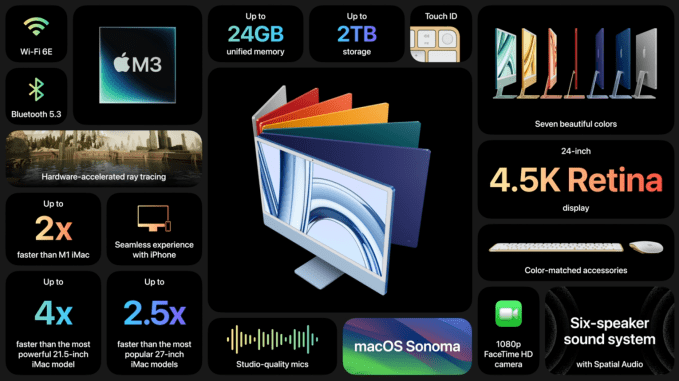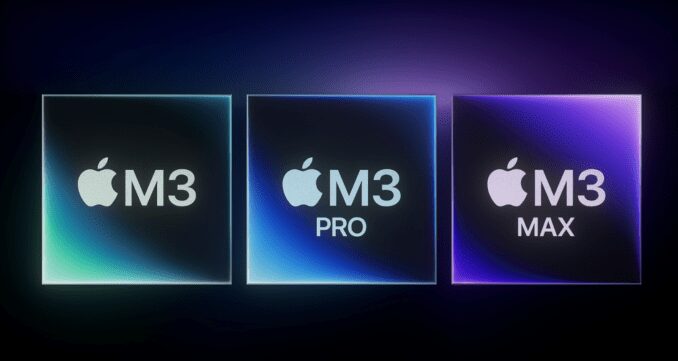It’s time for another Apple event, with a spooky twist. The company announced a surprise “Scary Fast” event last week, prompting the rumor mill to speculate that Apple would be revealing new chips to power a new lineup of Macs.
As our resident Apple expert Brian Heater wrote, a new 24-inch iMac and a MacBook Pro refresh would be the most likely new announcements to expect from the October event, and as it turns out, he was spot-on. Apple’s new M3 chip lineup was the focal point of the event, powering each of the devices Apple showcased in their half-hour prerecorded event that had some fog, some bats and ominous choir music…but no big surprises for those following the rumor mill.
Since the event kicked off off at the uncharacteristically late time of 8pm ET / 5pm PT, so you might have missed out out on the reveals while putting the finishing touches on your Halloween decorating, or watching Monday Night Football. No judgement, we’re here to recap everything the October Apple event showcased in one spot.
New M3 chips
The “scary fast” part of the Apple event, as expected, are the new M3 chips. Apple has announce a M3, M3 Pro and M3 Max, which will be included in Apple’s new 24-inch iMac, MacBook Pros.
This time around, Apple has placed an emphasis on graphical horsepower, with hardware-accelerated ray tracing, mesh shading and Dynamic Caching, which Apple claims “dramatically increases the average utilization of the GPU” by allotting exact amount of local memory to given tasks. These new chips were frequently benchmarked against their M1 predecessor, with Apple claiming the M3 renders at 2.5x the speed of the M1 and its CPU is 30% faster than the M1.
Check out the full rundown of the three M3 chips right here.
New MacBook Pro models

Credit: Apple
Yes, the new 14-inch and 16-inch MacBook Pros come with upgraded internals, but the first thing you might notice is the new color: Space Black. Beneath that color, you’ll find that new line of M3 chips. The 14-inch MacBook Pro can contain any of the trio, while the 16-inch model will only come with the M3 Pro or M3 Max chips.
As we’ve noted, the M3 chips packed into both models are putting an emphasis on getting the most out of the new GPU, though Apple also boasts that both form factors’ battery can last 22 hours on a single charge.
Both are available for preorder tonight, with the 14-inch MacBook Pro starting at $1,599 and going to $1,999 with the M3 Pro. The baseline 16-inch MacBook Pro goes for $2,499 and the pricing for the M3 Max chip upgrade for both models has yet to be disclosed.
And that space black color is exciting news for any Mac fan still pining for the 2006 MacBook, whose dark tone hadn’t been replicated in the MacBook iterations that followed, even those Midnight MacBook Airs.
Check out the full rundown on the new MacBook Pros here.
New M3 iMac

Credit: Apple
Apple’s iMac line is getting a colorful refresh, with an added M3 chip to add horsepower to the palette change. Apple is sticking with the 24-inch form factor, and upgrading the screen with a 4.5K retina display, 1080p FaceTime camera and a six-speaker system supporting Dolby Atmos and Spatial Audio. The new iMac will be available for preorder with green, yellow, orange, pink, purple, blue and silver options starting tonight.
The $1,299 baseline comes with a 8-core GPU and 8-core CPU, with a $1,499 version upgrading you to a 256 SSD.
For more info about what else is new in the M3 iMac, head here.
An sneaky iPhone showcase
You may not have noticed it, but at the very end of the event, Apple dropped a quick note on the stream: “This event was shot on iPhone and edited on Mac.” It’s a bit of a victory lap, but as our other Apple expert Darrell Etherington notes, it’s a pretty impressive flex for Apple to shoot its half-hour hardware showcase entirely on a phone.
Recap the full Scary Fast event
If you want to just dive right in and experience the October event all over again or for the first time, you can catch the entire archive via the YouTube embed below right on Apple’s website.

 News4 days ago
News4 days ago
 News6 days ago
News6 days ago
 News4 days ago
News4 days ago
 News3 days ago
News3 days ago
 News4 days ago
News4 days ago
 News4 days ago
News4 days ago
 News4 days ago
News4 days ago













